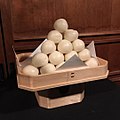Dango
Dango (団子) is a Japanese dumpling made from mochiko (rice flour). It is sticky and filling. It is often served with green tea.
Dango are eaten throughout the year, but the different types are traditionally eaten in certain seasons. Three to four dango are often served on a skewer. One variety of dango from Hokkaidō is made from potato flour and baked with shoyu (soy sauce).
A common Japanese proverb "Hana yori dango" (花より団子, which translates as "dumplings rather than flowers") is related to the custom of cherry blossom viewing (hanami).[1]
Types of dango
There are many different varieties of dango which are usually named after the various seasonings served on or with it.
- Botchan dango: Dango that is three colors. One is colored by red beans, the second by eggs, and the third by green tea. Botchan dango are often seen in Japanese anime, and are a common dish during hanami.
- Chichi dango: Slightly-sweet, usually eaten as a dessert.
- Goma: sesame seeds. It is both sweet and salty.
- Kinako: A toasted soy flour.
- Kushi dango: Dangos held by a skewer
- Mitarashi: A syrup made from shoyu (soy sauce), sugar and starch. Popular with children and women.
- Nori: dried and seasoned seaweed
- Kibidango: made from millet, and are actually dumplings.
Dango Media
Mitarashi dango, covered with sugar and soy sauce
Kusa dango
Anko dango
Kinako Dango.
References
- ↑ About.com, "Proverbial flower" → Hana yori dango 花より団子 Archived 2014-08-28 at the Wayback Machine. Retrieved 2012-6-20.
Other websites
![]() Media related to Dango at Wikimedia Commons
Media related to Dango at Wikimedia Commons








